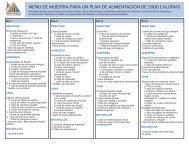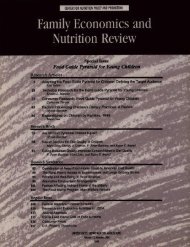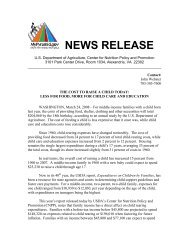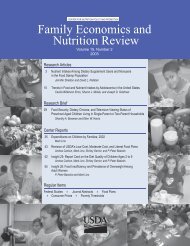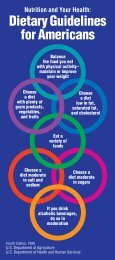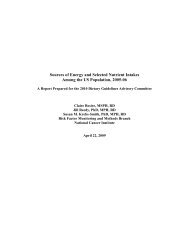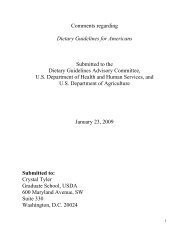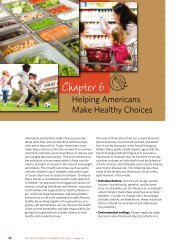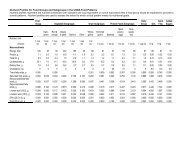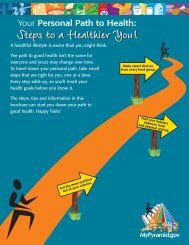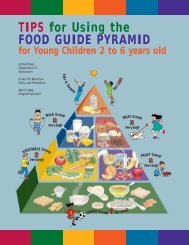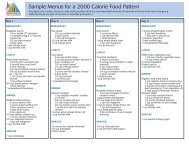Elderly Nutrition - Center for Nutrition Policy and Promotion - US ...
Elderly Nutrition - Center for Nutrition Policy and Promotion - US ...
Elderly Nutrition - Center for Nutrition Policy and Promotion - US ...
Create successful ePaper yourself
Turn your PDF publications into a flip-book with our unique Google optimized e-Paper software.
money started to become depleted<br />
because of extra Christmas expenses.<br />
The interviews also highlighted the<br />
importance of charitable food baskets<br />
at Christmas <strong>for</strong> some participants.<br />
(4) Another event occurred when the<br />
Caucasian male participant—on the<br />
recommendation of others in his<br />
building—decided to try food shopping<br />
rather than eating out at a snack bar<br />
each evening. By following this<br />
recommendation, he spent more money<br />
than he would have spent otherwise.<br />
The result: Be<strong>for</strong>e the end of the<br />
month, this elderly participant needed<br />
to borrow money <strong>and</strong> use credit to eat.<br />
Perhaps this was because he was not<br />
used to shopping <strong>for</strong> groceries.<br />
(5) One elderly woman’s health, social<br />
support, <strong>and</strong> food situation changed<br />
dramatically during the 4-month study.<br />
This participant was on a diet described<br />
as lowfat, low-cholesterol, low-sugar,<br />
low-sodium, <strong>and</strong> limited-greens. (The<br />
latter was due to a history of blood<br />
clots <strong>and</strong> medication <strong>for</strong> it. Based on<br />
her interpretations, she believed she<br />
was not allowed to eat anything<br />
“green.”) The weekly telephone<br />
contact produced a greater underst<strong>and</strong>ing<br />
of how complicated it was<br />
<strong>for</strong> this participant to follow her diet—<br />
especially given her low income. In<br />
addition, during the time that the<br />
telephone interviews were conducted,<br />
this elderly participant experienced<br />
several major life changes. After having<br />
heart surgery, she moved in with her<br />
elderly boyfriend so that he could<br />
take care of her. At the same time, she<br />
continued to pay <strong>for</strong> her own house,<br />
which caused financial difficulties.<br />
(She did not feel secure enough with<br />
her new situation to sell her house.)<br />
Living with her boyfriend who had<br />
no diet limitation made it even more<br />
difficult <strong>for</strong> her to follow her fairly strict<br />
diet. Our previous work showed that<br />
the ability to eat the “right foods <strong>for</strong><br />
health” was an important aspect of food<br />
security among the elderly, <strong>and</strong> her new<br />
social situation seemed to make this<br />
woman even more food insecure. Then,<br />
just be<strong>for</strong>e our study ended, she was<br />
diagnosed with breast cancer. This new<br />
life-altering event—plus the negative<br />
effect of living with someone with very<br />
different food habits—caused her to<br />
conclude that her diet really did not<br />
matter anyway. As a result, she<br />
stopped following her diet. It’s likely<br />
that her food situation changed further<br />
after her cancer surgery, which was<br />
scheduled after the end of our study.<br />
Thus, using the new concurrent events<br />
approach, compared with the two indepth<br />
interviews alone, produced a<br />
fuller underst<strong>and</strong>ing of changes as<br />
they occurred. This fuller underst<strong>and</strong>ing<br />
probably would not have<br />
been achieved with retrospective indepth<br />
interviews or event histories<br />
(Tuma & Hannan, 1984; Blossfeld &<br />
Rohwer, 1995). During the 4-month<br />
timeframe, however, there were not<br />
many substantial changes. The<br />
approach was relatively easy <strong>and</strong><br />
inexpensive to implement, requiring<br />
only about 10 minutes to interview<br />
each participant each week.<br />
Conclusions<br />
The weekly telephone calls provided<br />
good rapport between the elderly foodinsecure<br />
participants <strong>and</strong> the interviewer<br />
<strong>and</strong> provided a fuller underst<strong>and</strong>ing<br />
of food insecurity, social<br />
support, other events, <strong>and</strong> experiences<br />
among these elderly participants. These<br />
calls added to what was achieved in<br />
the two prior in-depth interviews. The<br />
concurrent events approach was not<br />
efficient <strong>for</strong> underst<strong>and</strong>ing the variability<br />
of social support or the effect<br />
of stressful events on food insecurity,<br />
however, because these events did not<br />
occur very often. The approach might<br />
be more efficient (<strong>for</strong> the same amount<br />
of interviewer time input) by first<br />
The concurrent events approach<br />
is likely to be useful <strong>for</strong><br />
investigation following an event<br />
or transition such as participating<br />
in the home-delivered meals<br />
program, moving into senior<br />
housing, loss of a spouse, moves<br />
by family members, or a change<br />
in health condition.<br />
2003 Vol. 15 No. 1 29



